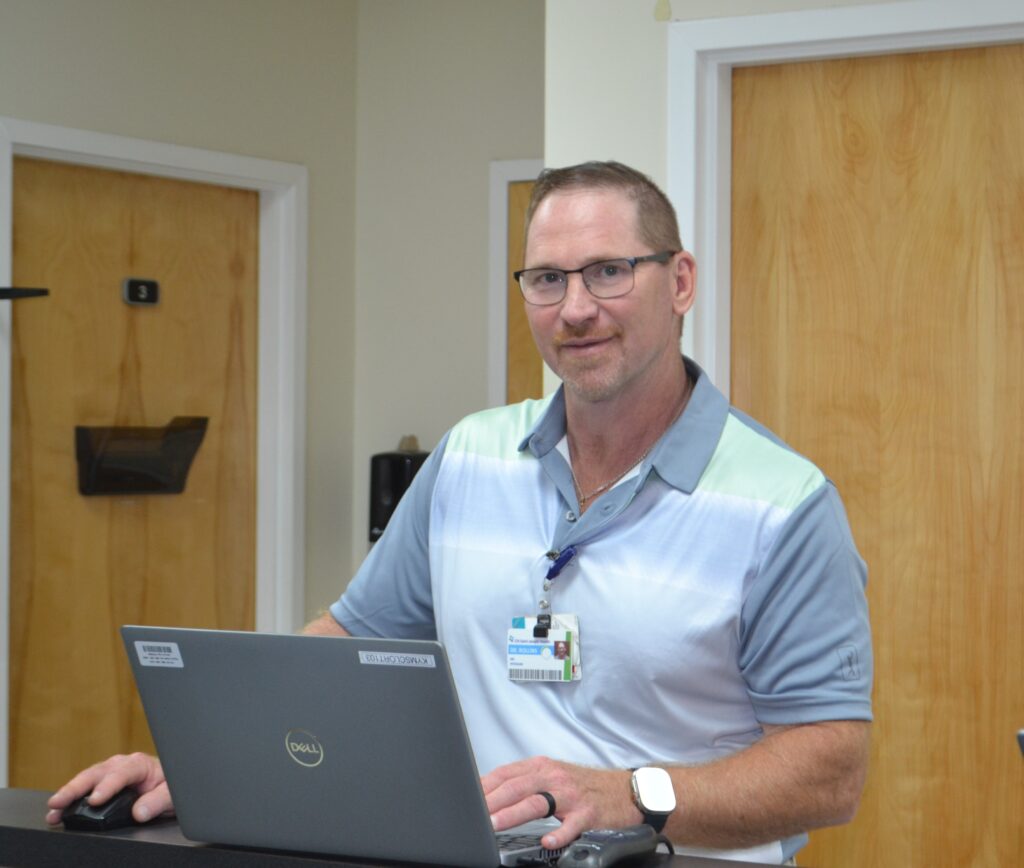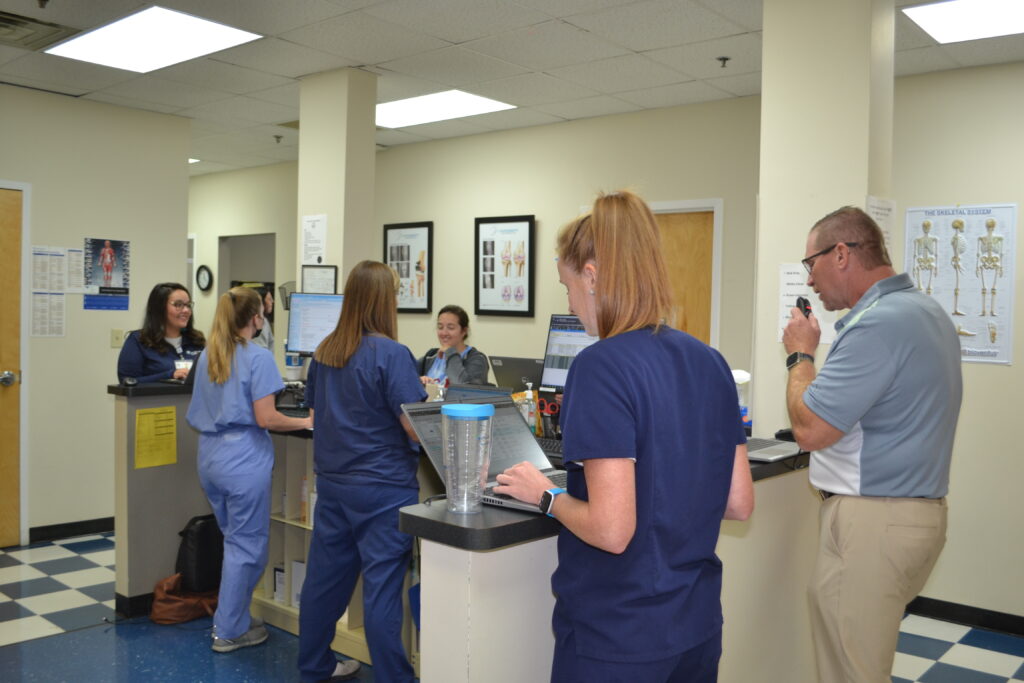Years of practice in the same town means generations come to see the CHI Saint Joseph Health orthopedist
MOUNT STERLING Most small towns have a family physician, the doctor who treats generations of patients, attends the local high school events, and advocates for the health of the population. Mount Sterling is lucky to have its own local orthopedist. Jim Rollins, MD, has been a Montgomery County fixture for over 20 years, just as likely to be spotted on the football sidelines as in his pew at church. His practice, as part of CHI Saint Joseph Medical Group – Orthopedics, has him healing bone and joint injuries and performing joint replacements, just the way he had envisioned it during medical school; helping the same families year after year, caring for young athletes, along with folks drawn in from the wider region.
Rollins grew up in central Ohio and owes his profession to a football injury. As a high schooler, the orthopedist who treated his back served as an inspiration and a motivator. Instead of his college plan for architectural engineering, Rollins migrated to medicine, with that same orthopedist remaining a mentor through those years. After getting his medical degree from the Medical School of Ohio, now the University of Toledo, Rollins had a residency mentor whose style of practice was to be emulated. Orthopedist Anthony Frogameni, MD, impressed Rollins with how he integrated into his community and how he worked with patients. This style guided Rollins in the creation of his Mount Sterling practice.
Rollins and his wife, along with their two sons, arrived in the area in the late 1990s to be nearer to her family. He soon had his practice up and running and within a few years, his pattern

“I have developed a pretty good relationship with my patients. Now I am seeing the children of some of my patients.”
was set. Local people with joint wear and tear or work or sports related injuries comprised the bulk of his patients, along with plenty of folks from further east and southeastern Ohio. For a time, he was interested in hand surgery and foot and ankle injuries, but he has migrated to joint replacement as his surgical focus.
Local Concerns, Local Involvement
Rollins’ patient population ranges from 10–90, and like most Kentucky physicians, his practice is informed by the common health concerns of the Commonwealth’s population. Obesity, diabetes, and generational sense of autonomy, so common in his patient population, concern him because of the added impact to common joint maladies. He tries to work with his patients to reduce these risk factors, and he will not perform surgery on patients whose BMI exceeds 40.
Rollins rues the independence of some of his eastern Kentucky neighbors, noting that many with minor joint injuries could avoid later surgery if they saw him sooner. He always tries conservative measures first — medical interventions, physical therapy, injections, lubrication, arthroscopy, to name a few — but some patients won’t come to him until it is too late for these things, and joint replacement is the only option.
Rollins says his practice has a family atmosphere to it. He notes that people in his region often come into their appointment with 4–5 different family members, and he is seeing a second generation of patients. Multiple times he has treated the children of people he treated a few decades ago. “With over 22 years there,” he says, “I have developed a pretty good relationship with my patients. Now I am seeing the children of some of my patients.” Rollins is also a fixture on the Montgomery County football team sidelines, having served as the home game physician for over 20 years. He enjoys being part of the student experience and providing the immediate care that may prevent later extensive joint damage.
Rollins knows many of his patients well. Often people he has treated for minor issues return years later for joint replacements. “I get to see the full range: some of my patients had arthroscopic surgery years ago, then as they get older, they are getting a joint replaced.” And they clearly value this familiarity. He notes that “People come by the house all the time saying, ‘I need to see you — can you get me in?’”
Evolving Needs and Evolving Practice
Rollins has watched his sports medicine work evolve over the years with the increase of competitive activities. He has always seen a lot of young athletes, but now the population has two distinct characteristics. He sees more young women than he used to, as so many girls now participate in competitive cheerleading and contact sports. In addition, he sees more stress injuries that come with the longer, more intense seasons many athletes are involved with. The chance to play a sport year-round at the competitive level brings damage that the three-sport athlete rarely risked.
Rollins always wants better for his patients, as any neighbor would. His preference for a conservative approach with early intervention is an example of this. His work to counsel his patients on their general health is another. He cites common variables to treatment and

recovery, such as depression and anxiety; these hinder healing in his patients and he speaks to them about it. Technology has improved his practice over the years. He currently uses a computer navigation program during surgery and notes that post-operative management is easier with this. “Our instrumentation comes from years of designs — and we are getting better at tracking patients because of the technology,” he says. He is currently working to get robotic surgery as an option for the Mount Sterling office, noting “It has been proven to reduce patient pain and recovery time — it makes a difference.” He would like his patients to have access to robotic surgery because “There are fewer variables — it just does not miss.”
Rollins’ philosophy of care is simple. He says, “I treat my patients like how I would want to be treated — and I tell them what I would want a member of my family to be told.” He prefers they come to him sooner rather than later, but respects their independent nature. His faith helps this, as he believes that “God is the greatest healer, and there are times when he can do the healing, not me.”
Without an orthopedist like Jim Rollins, Mount Sterling and Montgomery County would be a lesser place. Active student athletes, farmers and laborers, and an aging population of former blue-collar workers means joint injuries abound, and having an orthopedist who is accessible and integrated to the community lessens the impact of these things. Rollins would not want it any other way, concluding, “My phone number is out there, so I get called a lot. It’s kind of a small community.”



